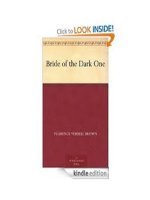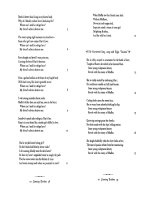Coming Out of the Dark
Bạn đang xem bản rút gọn của tài liệu. Xem và tải ngay bản đầy đủ của tài liệu tại đây (1.4 MB, 7 trang )
COMING OUT OF
Brenda Hoddinott
G-02 BEGINNER: SHADING FORMS
In this lesson you draw the three-dimensional
form of a sphere with a focus on light,
shadows, and a cast shadow. The medium is
charcoal, and erasers are the drawing tools.
The technique of taking away values, rather than adding them, is very popular in art classes,
especially still life and figure drawing. Many beginners love this method, because it focuses on
creating light and dark values separately, rather than rendering a full range of values all at once.
This project is divided into the following two sections:
Ü DRAWING WITH ERASERS: Most artists are familiar with drawing dark values on a
light surface. However, as you will soon see, you can also draw light values on a dark surface
by using an eraser (or erasers). In this section, you experiment with two different types of
erasers as drawing tools.
Ü COMING OUT OF THE DARK: I take you step-by-step through a drawing of a spherical
form. You draw light with erasers, and shadows with pencils. In other words, you take away
values rather than adding them! Form, as applied to drawing, is the illusion of the three-
dimensional structure of a shape, such as a circle, square or triangle, created in a drawing
with shading and/or perspective.
Suggested drawing supplies include a 2B or 4B charcoal stick, 2B or 4B charcoal pencil, vinyl
eraser, kneaded eraser, heavy white drawing or watercolor paper, and paper towels.
7 PAGES – 7 ILLUSTRATIONS
This project is recommended for artists from age 10 to adult, as well as home schooling,
academic and recreational fine art educators.
Published by Hoddinott Fine Art Publishers, Halifax, NS, Canada – Revised 2006
Copyright to all articles, images, text, projects, lessons and exercises within this drawing class belong to Brenda Hoddinott and may
not be reproduced or used for any commercial purposes whatsoever without the written permission of Brenda Hoddinott.
Web sites and
2
DRAWING WITH ERASERS
Most artists are familiar with drawing dark values on a light surface. However, as you will soon
see, you can also draw light values on a dark surface by using an eraser (or erasers). Values are
different shades of gray created in a drawing, by various means, such as varying both the density
of the shading lines, and the pressure used in holding your pencils. Shading refers to the various
shades of gray (values) in a drawing that make drawings look three-dimensional.
In this section, you experiment with erasers as drawing tools. You need the following two
different types of erasers:
Vinyl eraser: works well for drawing really light areas and fine details. If the edge of
your vinyl eraser gets too dull to draw properly, just cut off a new piece (about an inch
long) or simply cut a small slice off the end with a very sharp blade or knife.
Kneaded eraser: is great for lightening large areas. You can either pat or gently rub the
surface of your paper. To draw fine detail, simply mould the tip of the eraser to a point
or wedge. To clean your kneaded eraser, simply stretch and reshape (also known as
“kneading”) it several times until it comes clean.
ILLUSTRATION 02-01
1) Use your darkest pencil to
smoothly shade in the entire area
of a drawing surface.
A drawing surface (also called a
drawing space or drawing format)
refers to the area in which you render
a drawing. Mine is 6 by 3 inches.
Use the side of the pencil point,
instead of the tip. It’s faster and you
end up with a smoother surface.
2) With a piece of paper towel or soft tissue, very gently blend the whole surface,
until you have a solid tone.
ILLUSTRATION 02-02
Blending is the process of rubbing
shading lines with a blending tool
(such as tissue or paper towel) to
evenly distribute the drawing
medium over the surface of the
paper.
Don’t apply too much pressure, or
you’ll grind the graphite into the
paper so much that it won’t erase
(thereby defeating the whole purpose
of this exercise).
Copyright to all articles, images, text, projects, lessons and exercises within this drawing class belong to Brenda Hoddinott and may
not be reproduced or used for any commercial purposes whatsoever without the written permission of Brenda Hoddinott.
Web sites and
3
ILLUSTRATION 02-03
3) Use your erasers
however you wish to
experiment with pulling
light values from the
dark drawing surface.
COMING OUT OF THE DARK
Time to put a twist into your notions on drawing a sphere, by pulling light values from a dark
surface! In this section, I take you step-by-step through a drawing of a spherical form. Form, as
applied to drawing, is the illusion of the three-dimensional structure of a shape, such as a circle,
square or triangle, created in a drawing with shading and/or perspective. You draw light with
erasers, and shadows with pencils. You practice taking away values rather than adding them!
ILLUSTRATION 02-04
1) Shade in a section of your
drawing space with your
stick of charcoal.
Use the side of your charcoal
instead of the end. It’s faster.
If you are using graphite
instead of charcoal, use a
dark pencil such as an 8B.
2) With a piece of paper
towel or soft tissue, gently
rub the surface until you
have a solid tone.
This shaded background is
your middle value. Your
erasers will create the lighter
values and you’ll use your
charcoal pencil to shade the
darker values.
Copyright to all articles, images, text, projects, lessons and exercises within this drawing class belong to Brenda Hoddinott and may
not be reproduced or used for any commercial purposes whatsoever without the written permission of Brenda Hoddinott.
Web sites and
4
3) Shake the extra charcoal off your paper into the garbage.
4) Use your kneaded eraser to begin erasing or “pulling out” the light areas.
Erase, pat, and pull out light areas until you can identify a circular shape. Shape refers to
the outward outline of a form. Basic shapes include circles, squares and triangles.
The light source is coming from the upper left, which affects the placement and value of
every section of shading. Light source is the direction from which a dominant light
originates. The lighter values closer to the light source, are near the top of the sphere. The
tiny glow on the lower edge of the circle is the reflected light. Reflected light is a faint rim
of light reflected or bounced back on an object from the surfaces close to and around the
object, such as the surface on which the object is sitting.
By the way, don’t worry if your circle looks more like a kidney! The goal of this project is
to draw a three-dimensional shape.
ILLUSTRATION 02-05
Copyright to all articles, images, text, projects, lessons and exercises within this drawing class belong to Brenda Hoddinott and may
not be reproduced or used for any commercial purposes whatsoever without the written permission of Brenda Hoddinott.
Web sites and
5
5) Use a sharp edge of your vinyl erase to “pull out” the white area (the highlight)
in the upper area of the circle as shown.
A highlight is the brightest area of an object; usually, the section that is closest to the light
source. Don’t worry if it doesn’t come completely white (mine didn’t). But it should look a
little whiter than the light area around it. Less light reaches the other surfaces of the sphere
that are closer to or in the shadowed areas. Shadows are the areas on (or adjacent to) an
object that receive little or no light.
ILLUSTRATION 02-06
6) With your
charcoal
pencil draw
an outline
around your
shape.
This step is
optional; you
may prefer to
leave the
edges soft.
You can draw
this circular
(or kidney
shaped)
outline
freehand if
you wish, or
even use a
compass to
draw a circle
if you are
fussy picky
like me.
7) Use your charcoal pencil to add dark shading to the shadow sections of the circle.
The shading in the shadow area looks like a crescent shape or backwards “C” (refer to
illustration 01-06).
8) Draw the cast shadow underneath the sphere.
The cast shadow is on the surface, under and to the right of the sphere. The shading in a
cast shadow is darker closer to the object and becomes gradually lighter toward the outer
perimeter. A cast shadow is a dark area on a surface, adjacent to where the light is blocked
by an object.









